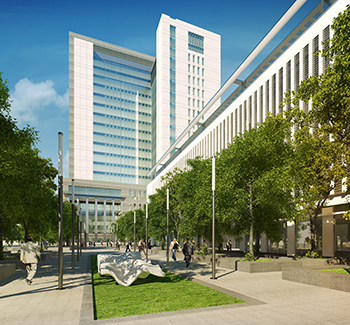A New Courthouse Paradigm
 SAN FRANCISCO — The traditional courthouse will become obsolete in 20 to 30 years, according to Chuck Oraftik, FAIA, justice director at HOK’s San Francisco office.
SAN FRANCISCO — The traditional courthouse will become obsolete in 20 to 30 years, according to Chuck Oraftik, FAIA, justice director at HOK’s San Francisco office.
In the presentation “A New Courthouse Paradigm: Changing Technologies, Economies and Community Expectations”, members of the American Institute of Architects and representatives of the National Association for Court Management discussed the future of judicial facilities and how societal changes are affecting courthouse design.
“I have a feeling that we’re on the cusp of something new,” Oraftik said. “We just don’t know what that is yet.”
The discussion surrounded how changing norms will change the function and operations of court facilities. The upcoming generation brings a whole new set of expectations, Oraftik said. The justice director likened today’s courthouse to how architects and planners see current 1970s era courthouses.
“We decided we’re going to take a leap ahead,” Oraftik said. “We need to see beyond immediate needs so this doesn’t happen again to the next generation.”
New court norms such as instant communication and tiered service delivery partnered with an increased demand for increased speed and access to services are driving several changes in courthouse operations.
Peter Kiefer, administrator at Maricopa Superior Court, presented the findings of a survey that questioned the probability of over 40 scenarios occurring before the year 2025. Survey participants were asked to rate the likelihood of the scenario on a scale one to five, with a one score considered the most likely scenario.
Of the 40 scenarios, the most likely possibility presented is that courts will go “paperless.” This scenario, which was rated at a likelihood of 1.7, is already taking reign in several courthouses throughout the nation, Kiefer said.
“This scenario almost looks like a no brainer that will occur in the next 10 to 15 years in most courts,” Kiefer said.
The probability of centralized data storage and centralized data will be immediately available was assessed as highly likely with a rating of 1.8. A database with accurate criminal history is going to become exceedingly important in the future, Kiefer said.
Rated at a likelihood of 2.0, electronic monitoring is believed to become a norm by 2025. However, because probation if often considered a more lenient sentence, only time will tell how the public and courts will feel about electronic monitoring in the future.
“We’ll have to see if the law looks at these sanctions more favorably,” Kiefer said.
Other scenarios that survey found were likely and would affect the court system were an increase to case complexity, intermediate sanctions will dominate criminal and traffic offenses, the gap will widen between the public’s expectations and court’s capacity, parking and lower level traffic cases will be handled administratively
Major operation changes will demand a new courthouse paradigm, Oraftik said. An increasingly large number of cases, questions and issues that would have been addressed in the physical courthouse in the past will soon be handled online. Oraftik added that he believes courthouses will morph into large, centralized justice centers.
Spaces such as law libraries, parking lots, high volume lobbies and evidence storage will become smaller, fewer or obsolete, while self-help facilities, media centers and self-serve remote kiosks will become more heavily utilized. Judicial facilities will also have more flexible and adaptable courtrooms.
The new justice center will have several changes including a much larger self-help component, support services and high security data and communication center. The survey will also prove as a useful tool for clients planning judicial facilities that will reflect the future.
“Courts are taking baby steps,” Oraftik said. “I think these baby steps will soon turn into giant leaps.”
